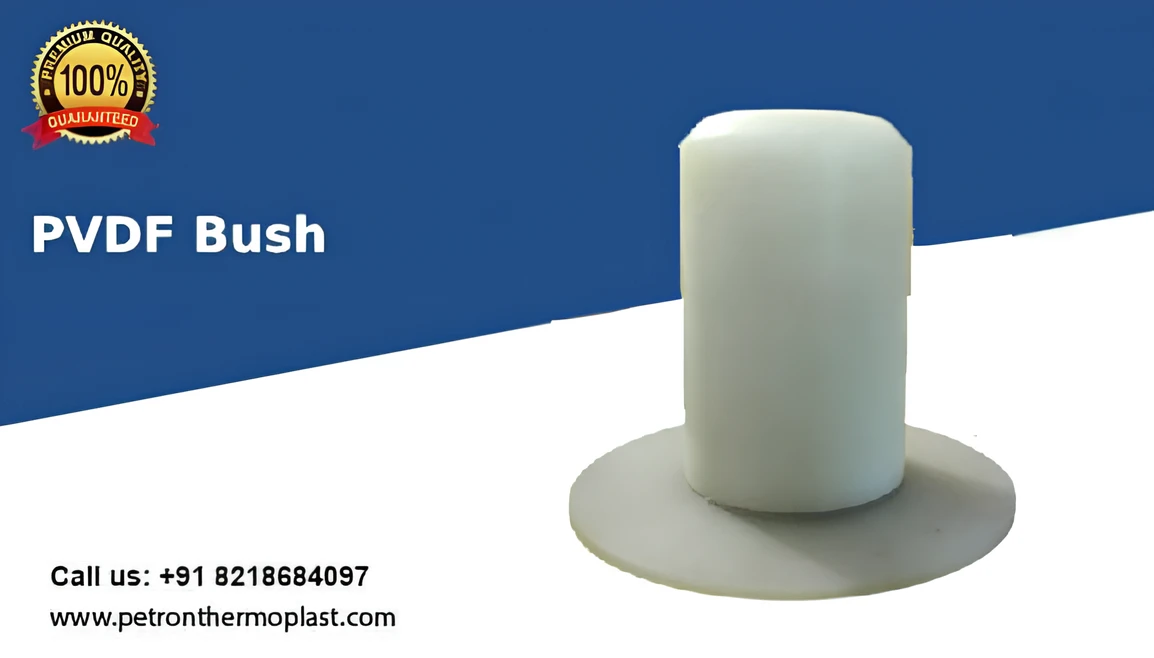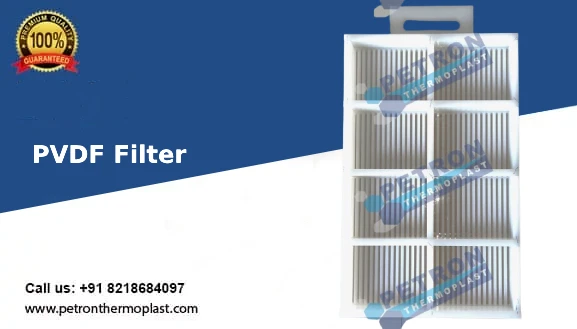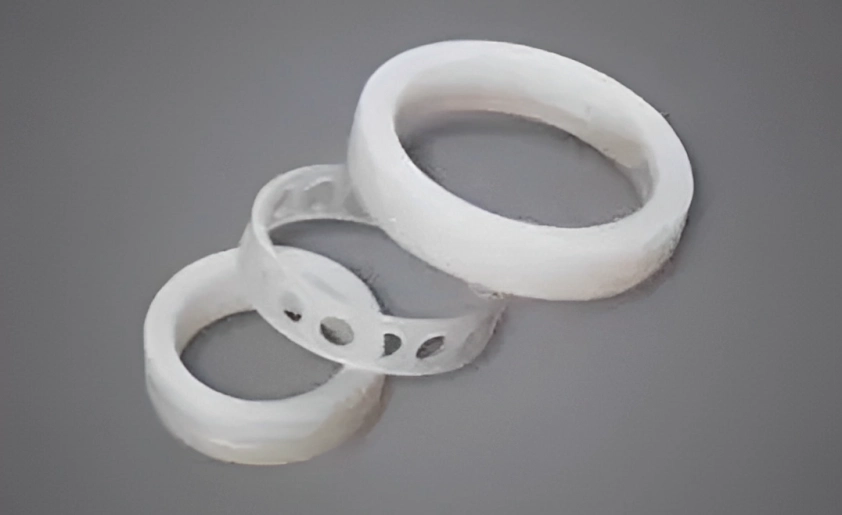PVDF Engineering Plastic Components

PVDF Spool
PVDF (Polyvinylidene fluoride) spools are commonly used in various industrial applications, particularly in the field of fluid handling and chemical processing. Below are some technical details you might find useful for a PVDF spool:
Material Specifications:
- Material: PVDF (Polyvinylidene fluoride)
- Density: Typically around 1.78 g/cm³
- Melting Point: Approximately 170-175°C (338-347°F)
- Tensile Strength: 40-60 MPa
- Elongation at Break: 50-150%
- Chemical Resistance: Excellent resistance to a wide range of chemicals, acids, and solvents.
Temperature and Pressure Ratings:
- Temperature Range: PVDF is known for its high-temperature resistance, making it suitable for applications in a wide temperature range, from sub-zero to elevated temperatures.
- Pressure Rating: Specify the maximum operating pressure the spool can handle.
Dimensions:
- Diameter: Specify the outer and inner diameters.
- Length: Provide the overall length of the spool.
- Wall Thickness: Indicate the thickness of the PVDF material used in the spool.
Connections:
- Specify the type of connections on both ends of the spool (e.g., threaded, flanged) and the standard used (ANSI, DIN, etc.).
Color:
- PVDF spools are typically available in a natural, translucent color. However, custom colors may be available upon request.
Manufacturing Process:
- PVDF spools are often manufactured through processes like injection molding or extrusion, ensuring consistent quality and dimensional accuracy
Additional Features:
- If the spool has any special features such as UV resistance, flame retardancy, or specific reinforcements, provide details about those.
Maintenance and Care:
- Include any recommended maintenance procedures and guidelines for handling and storing PVDF spools to ensure their longevity.
Applications:
- PVDF spools are commonly used in chemical processing, water treatment, semiconductor manufacturing, and other industries where excellent chemical resistance and thermal stability are crucial.
Compliance and Certifications:
- Ensure that the PVDF spools comply with relevant industry standards and regulations. Certifications such as NSF, FDA, or others may be applicable depending on the specific application.
Always consult with the manufacturer or supplier for the most accurate and up-to-date technical details specific to the PVDF spool you are considering for your application.

PVDF Bush
Polyvinylidene fluoride (PVDF) is a suitable material for use in high-temperature and corrosive environments, such as a Sulphuric acid line. PVDF possesses excellent chemical resistance, thermal stability, and mechanical strength. When designing a PVDF bush for use in a Sulphuric acid line, it’s important to consider factors such as dimensions, installation, and temperature conditions. Here’s a basic outline for creating a PVDF bush for this application:
Material Selection:
- PVDF is chosen for its excellent chemical resistance to Sulphuric acid and high-temperature stability.
- Ensure the PVDF material complies with relevant industry standards and specifications.
Dimensions:
- Determine the appropriate dimensions based on the specific requirements of your Sulphuric acid line.
- Consider factors such as inner and outer diameters, length, and tolerances.
Testing and Quality Control:
- Implement a rigorous testing process to ensure the PVDF bush meets all specified requirements.
- Conduct quality control checks to verify dimensions, material integrity, and chemical resistance.
Surface Finish:
- Consider the required surface finish to minimize friction and facilitate ease of installation.
- Smooth surfaces help in reducing the chances of material buildup and corrosion.
Installation:
- Design the bush for easy installation and removal, ensuring a secure fit within the Sulphuric acid line
- Include features such as flanges or grooves for proper alignment.
Compliance:
- Ensure that the PVDF bush complies with relevant industry standards and regulations for materials used in Sulphuric acid lines.
Manufacturing Process:
- Select an appropriate manufacturing process, such as injection molding or machining, depending on the complexity and quantity of the bush required.
- Ensure that the manufacturing process maintains the integrity and chemical resistance of the PVDF material.
Temperature Considerations:
- PVDF is known for its high-temperature resistance, but it's essential to consider the specific temperature conditions in your Sulphuric acid line.
- Ensure that the PVDF bush can withstand the maximum temperature of the application without compromising its structural integrity.
Chemical Resistance:
- Confirm that the PVDF material is resistant to Sulphuric acid concentrations and any other chemicals present in the process.
- Consider the potential for chemical exposure over time and ensure the bush's longevity in such conditions.
Testing and Quality Control:
- Implement a rigorous testing process to ensure the PVDF bush meets all specified requirements.
- Conduct quality control checks to verify dimensions, material integrity, and chemical resistance.
Polyvinylidene fluoride (PVDF) is a thermoplastic polymer that possesses excellent chemical resistance, making it suitable for applications involving harsh chemicals like sulfuric acid. Here’s a description of a PVDF filter designed for use in a high-temperature line with corrosive water, such as sea water. Keep in mind that specific design details would depend on the exact requirements and conditions of your system.
Remember to consult with materials engineers and professionals familiar with the specific requirements of your Sulphuric acid line to ensure the design meets all safety and performance standards.

PVDF Filter
The PVDF filter is engineered for demanding applications involving both high temperatures and corrosive water, particularly in scenarios where sea water is a significant challenge. It provides robust filtration to ensure the integrity of downstream equipment and processes.
Material Composition:
- Housing: PVDF (Polyvinylidene Fluoride)
- Filter Element: PVDF with high-temperature resistance
- O-rings and Seals: FKM (Fluoroelastomer) for enhanced chemical compatibility
Temperature Resistance:
- Designed to withstand high temperatures encountered in industrial processes.
- Operating temperature range: [Specify the temperature range in degrees Celsius or Fahrenheit].
Applications:
- Suitable for industrial processes involving the filtration of sea water with high temperatures and aggressive chemicals.
- Ideal for use in petrochemical plants, refineries, and other corrosive environments.
Chemical Compatibility:
- Resistant to corrosive substances, including sulfuric acid and other aggressive chemicals present in sea water.
- Suitable for a wide range of industrial fluids.
Filtration Efficiency:
- Multi-layer PVDF filter element ensures high filtration efficiency.
- Micron rating tailored to the specific requirements of the application.
Pressure Rating:
- Designed to handle the pressure associated with high-temperature and high-corrosion environments
- [Specify pressure rating in PSI or bar].
Connection Options:
- Available with various connection options, including threaded, flanged, or custom connections to meet specific installation needs
Ease of Maintenance:
- Quick and simple disassembly for routine maintenance
- Clear housing allows visual inspection of the filter element
Corrosion Resistance:
- PVDF construction provides excellent corrosion resistance, ensuring long-term durability
Installation Guidelines:
- Install the filter in the line upstream of sensitive equipment or processes.
- Ensure proper support and bracing to handle the weight of the filter in high-temperature environments.
It’s crucial to consult with the manufacturer or a qualified engineer to tailor the filter design to the specific requirements of your system. Additionally, compliance with industry standards and regulations should be ensured during the design and installation.
PVDF ENGINEERING PLASTIC COMPONENTS

What Is PVDF?
Polyvinylidene difluoride (PVDF) is an extremely expensive white, semi-crystalline, and semi-opaque engineering thermoplastic that people can process by melting.
PVDF plastic has good temperature and chemical resistance in general. It is resistant to abrasion and radiation. Furthermore, it has high dielectric losses, slightly stiffer and stronger than most (melt-processable) fluoropolymers.
Thermoplastic Form:
PVDF is a thermoplastic that can be heated until it melts and flows, making it useful for product manufacturing. Thermoplastics harden again after cooling.
This melting, reforming, and people can repeat the cooling cycle indefinitely. Injection moulding is a manufacturing process that makes use of this. It can be used to produce a large number of high-quality thermoplastic parts quickly and affordably.
PVDF Structure:
PVDF is a highly dipolar molecule, the proper morphology results in valuable piezo- and pyro-electric properties. Petron Thermoplast offers the best PVDF plastic, which Industry experts can use for various industrial purposes.
The preferred form is the ß phase or form I, in which polymer chains have an all-trans prolonged planar zig-zag form with neighbouring chains’ dipoles parallel to one another.
Relying on how the samples are prepared, the molecular and crystal structures of PVDF change. PVDF is available in five crystal structures: alpha, beta, gamma, delta, and epsilon. Other synthetic polymers lack PVDF’s complex crystalline polymorphism.
The beta phase is the most common and forms the major phases along with the alpha and gamma phases. H.
It is formed by mechanical deformation and polarisation at relatively high electrical fields from the more common Alpha phase. In practice, both biaxial and uniaxial mechanical rotations are used, resulting in a different balance of piezo-/pyro-electric properties after poling.
PVDF Plastic Applications:
When exposed to an electric field, materials with piezoelectric features and functionality tend to elongate due to mechanical strain generation. These materials are necessary for 3D printing electronic devices such as sensors and actuators.
PVDF is lead-free in addition to its piezoelectric properties, making it more suitable for biomedical applications and the food industry.
There are other major industrial applications. You can contact Petron Thermoplast for durable and best quality PVDF products.
WHAT IS PVDF ENGINEERING PLASTIC COMPONENTS?

PVDF Engineering Plastic Components: It is an elite and high-performance engineering plastic components. It is a moderately new fluoropolymer best respected for its resistance to chemicals. The Ductile pressure and compressive strength are strikingly higher.
PVDF material known as polyvinylidene fluoride is produced by Petron Thermoplast in standard stock shapes for machining in sheets and bars. The PVDF full form Polyvinylidene Fluoride is a misty, semi-translucent, or crystalline, thermoplastic fluoropolymer. PVDF shows phenomenal chemical obstruction without having the drawbacks of low mechanical qualities or potentially handling troubles which can be knowledgeable about other fluoroplastics. The PVDF Engineering PLASTIC Components material has a melting point of 171°C.
PVDF Engineering PLASTIC Components are available in numerous standard parts like- screws, hex head cap screws, hex nuts and washers, and also custom parts. Polyvinylidene fluoride is a semi-glasslike thermoplastic fluoropolymer. It is sold under the brand name Kynar®, Hylar®, Solef®, and others. It is esteemed for its virtue, chemical opposition, and electrical properties just as its protection from UV degradation and radiation. Likewise, it has a moderately high heat resilience. Due to these attributes, it is utilized in a wide variety of utilizations in numerous industries.
Properties of PVDF Engineering PLASTIC Components:
*High chemical resistance: PVDF parts show high protection from mineral acids and natural acids. Mineral acids incorporate hydrochloric, nitric corrosive, and sulfuric corrosive. Natural acids like lactic corrosive, and citrus extract don’t influence PVDF membrane. In this manner, PVDF membrane is utilized in food preparing hardware for its corrosive obstruction.
* High mechanical strength: PVDF materials are naturally solid and intense as reflected by their malleable properties and effect strength. An encompassing temperature elasticity at yield of 35-55 MPa (5,000-8,000 psi) and an un-notched sway or impact strength.
*High UV-resistance: PVDF structure is exceptionally resistant to UV radiation. When this plastic is added to coatings, PVDF paints have the most elevated UV resistance in the business.
*High tensile strength: Polyvinylidene fluoride shows a higher elasticity, pressure opposition, and dimensional solidness than the connected PTFE. However, contact and protection properties are lower. PVDF structure has a high mechanical strength and durability at lower temperatures, and it’s self-smothering. The working temperature goes from – 30 °C to +150 °C.
*High rigidity: PVDF sheet has high rigidity nature and pressing factor bearing limit, yet its perfection and electrical protection are superior to other plastic. It has high strength and high sturdiness under low-temperature conditions. PVDF linear bushes and bearing is steady to chloride, bromide, and energy beams.
*PVDF shows low water absorption: Plastics with exceptionally low water absorption are polymers like PEEK, PPS, PSU, PPSU, PEI, PVDF, PET, PPE, PP, and PE. Besides, low water assimilation is shown by POM, PA12, PC, and ABS. Polyamides (nylons) by and large show higher water assimilation than other designing plastics.
* Relatively high coefficient of thermal expansion: PVDF ROD Suppliers and Manufacturer in India, it is a profoundly crystalline unreinforced fluoropolymer consolidating great mechanical, heat, and electrical properties with magnificent chemical obstruction.
It additionally shows excellent protection from high-energy radiation (significantly better than other fluoropolymers). PVDF shows a high coefficient of thermal expansion because of its overwhelming properties.
* Good friction and wear and tear values: By and large, plastics are nice wear materials with a low coefficient of friction, making them ideal for applications where contact is a thought. Likewise, the scraped abrasion opposition of most plastics is additionally high under dry running conditions.
PVDF Industrial Parts Manufacturing Company Characteristics:
- High tensile strength
- High mechanical strength
- High rigidity (also at low temperature)
- High chemical resistance
- Very low water absorption
- Good friction and wear and tear values
- Self-extinguishing
- High UV-resistance
- Toxic fumes when burned
- Relatively high coefficient of thermal expansion
PVDF Industrial Parts Applications
- Gaskets
- Pumps
- Rotation discs
- Valves
- Check valves
- Extraction centrifuges
- Fittings
- Slide rails
- Gear wheels
Looking for PVDF components?
We are PVDF plastic engineering components manufacturers in India
GET THE LATEST PVDF Engineering Plastic Components PRICES ON YOUR EMAIL
